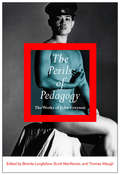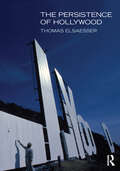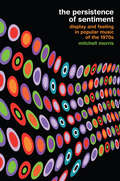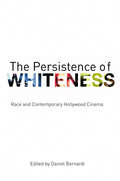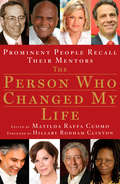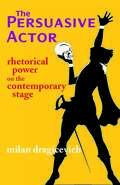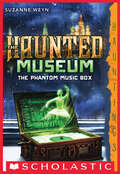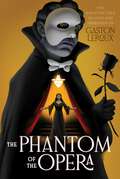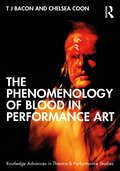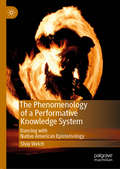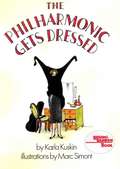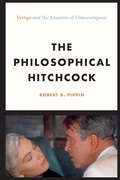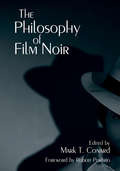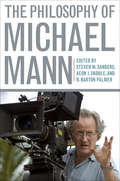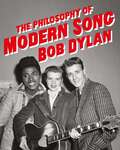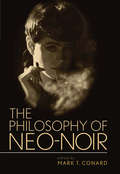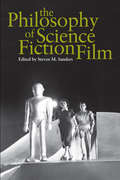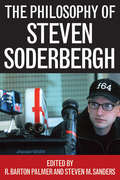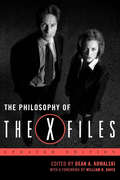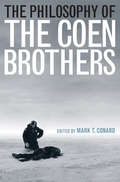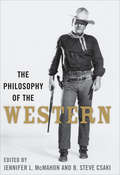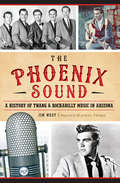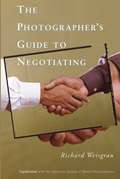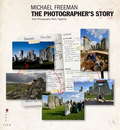- Table View
- List View
The Perils of Pedagogy: The Works of John Greyson
by Thomas Waugh Brenda Longfellow Scott MacKenzieWhether addressing HIV/AIDS, the policing of bathroom sex, censorship, or anti-globalization movements, John Greyson has imbued his work with cutting humour, eroticism, and postmodern aesthetics. Mashing up high art, opera, community activism, and pop culture, Greyson challenges his audience to consider new ways that images can intervene in both political and public spheres. Emerging on the Toronto scene in the late 1970s, Greyson has produced an eclectic, provocative, and award-winning body of work in film and video. The essays in The Perils of Pedagogy range from personal meditations to provocative textual readings to studies of the historical contexts in which the artist's works intervened politically as well as artistically. Notable writers from a range of disciplines as well as prominent experimental and activist filmmakers tackle questions of documentary ethics, moving image activism, and queer coalitional politics raised by Greyson's work. Close to one hundred frame captures and stills from almost sixty works, along with articles, speeches, and short scripts by Greyson - several never before published - supplement the collection. Celebrating thirty years of passionate, brilliant, and affecting moviemaking, The Perils of Pedagogy will fascinate both specialists and general readers interested in media activism and advocacy, censorship, and freedom of expression.
The Persistence of Hollywood
by Thomas ElsaesserWhile Hollywood’s success – its persistence – has remained constant for almost one hundred years, the study of its success has undergone significant expansion and transformation. Since the 1960s, Thomas Elsaesser’s research has spearheaded the study of Hollywood, beginning with his classic essays on auteurism and cinephilia, focused around a director’s themes and style, up to his analysis of the "corporate authorship" of contemporary director James Cameron. In between, he has helped to transform film studies by incorporating questions of narrative, genre, desire, ideology and, more recently, Hollywood’s economic-technological infrastructure and its place within global capitalism. The Persistence of Hollywood brings together Elsaesser’s key writings about Hollywood filmmaking. It includes his detailed studies of individual directors (including Minnelli, Fuller, Ray, Hitchcock, Lang, Altman, Kubrick, Coppola, and Cameron), as well as essays charting the shifts from classic to corporate Hollywood by way of the New Hollywood and the resurgence of the blockbuster. The book also presents a history of the different critical-theoretical paradigms central to film studies in its analysis of Hollywood, from auteurism and cinephilia to textual analysis, Marxism, psychoanalysis, and post-industrial analysis.
The Persistence of Sentiment: Display and Feeling in Popular Music of the 1970s
by Mitchell MorrisHow can we account for the persistent appeal of glossy commercial pop music? Why do certain performers have such emotional power, even though their music is considered vulgar or second rate? In The Persistence of Sentiment, Mitchell Morris gives a critical account of a group of American popular music performers who have dedicated fan bases and considerable commercial success despite the critical disdain they have endured. Morris examines the specific musical features of some exemplary pop songs and draws attention to the social contexts that contributed to their popularity as well as their dismissal. These artists were all members of more or less disadvantaged social categories: members of racial or sexual minorities, victims of class and gender prejudices, advocates of populations excluded from the mainstream. The complicated commercial world of pop music in the 1970s allowed the greater promulgation of musical styles and idioms that spoke to and for exactly those stigmatized audiences. In more recent years, beginning with the "Seventies Revival" of the early 1990s, additional perspectives and layers of interpretation have allowed not only a deeper understanding of these songs' function than when they were first popular, but also an appreciation of how their significance has shifted for American listeners in the succeeding three decades.
The Persistence of Whiteness: Race and Contemporary Hollywood Cinema
by Daniel BernardiThe Persistence of Whiteness investigates the representation and narration of race in contemporary Hollywood cinema. Ideologies of class, ethnicity, gender, nation and sexuality are central concerns as are the growth of the business of filmmaking. Focusing on representations of Black, Asian, Jewish, Latina/o and Native Americans identities, this collection also shows how whiteness is a fact everywhere in contemporary Hollywood cinema, crossing audiences, authors, genres, studios and styles. Bringing together essays from respected film scholars, the collection covers a wide range of important films, including Guess Who’s Coming to Dinner, The Color Purple, Star Wars and The Lord of the Rings. Essays also consider genres from the western to blaxploitation and new black cinema; provocative filmmakers such as Melvin Van Peebles and Steven Spielberg and stars including Whoopi Goldberg and Jennifer Lopez. Daniel Bernardi provides an in-depth introduction, comprehensive bibliography and a helpful glossary of terms, thus providing students with an accessible and topical collection on race and ethnicity in contemporary cinema.
The Person Who Changed My Life: Prominent People Recall Their Mentors
by Matilda CuomoAt some point in our lives, most of us have been affected by caring adults whose advice, guidance, and example made a difference. In The Person Who Changed My Life, individuals who have distinguished themselves in their fields write about the men and women who served as their mentors. Among the contributors in this updated and expanded edition of Matilda Raffa Cuomo's first book are Hillary Rodham Clinton, Joe Torre, Rosie O'Donnell, Dr. Mehmet Oz, Nora Ephron, General Colin Powell, and many others. The contributors evoke the people who had a lasting influence on their personal and professional lives and, in the process, show how profoundly a mentor can impact the life of a young, or not so young, person.The book includes a resource section for readers who are inspired to get involved and become mentors or help start mentoring organizations in their own communities. These moving stories by people who have excelled in their professions through hard work, perseverance, and, most important, the helpful assistance of others, demonstrate the long-lasting impact a mentor can have--and emphasize the importance of passing on the gifts our mentors give us.
The Persuasive Actor: Rhetorical Power on the Contemporary Stage
by Milan Dragicevich"A must-have for all actors who encounter speeches that are longer than three sentences. On the surface, that would be classic works from Sophocles through Shakespeare—with the 17th and 18th centuries thrown in. Dig deeper and the book’s value to actors of modern and contemporary drama is inescapable. Ibsen, Shaw, Williams, Miller, Shepard, Wilson, Kushner, and Suzan-Lori Parks all wrote plays that are filled with powerful rhetorical devices that demand lively, thorough, and specific consideration. This book is a guide that unfolds the mysteries of classical rhetoric in a clear, concise, and effective manner, a book for speakers who want to move their audiences. It is aimed at actors, but also belongs on the shelf of lawyers, advertising copywriters, and, of course, public officials. I will use it in my classes and workshops and enthusiastically recommended it to all actors and actor trainers." —Leslie Reidel, Department of Theatre, University of Delaware
The Phantom Music Box: The Phantom Music Box (The Haunted Museum #2)
by Suzanne WeynA mysterious music box from the Haunted Museum follows a young girl home in this spooky read by the author of The Titanic Locket.Don’t touch anything in the Haunted Museum!Emma would rather be at her ballet class than at the Haunted Museum, but she can’t miss her best friend’s birthday party. In a spooky exhibit of music boxes, she’s drawn to a particular one, in which a pair of dancers spin slowly to a haunting melody.But that very night, the music box shows up at her door—like it’s following her. Emma dances better than she ever imagined when the music box is playing. But that’s not all. Sometimes the music speeds up, and the dancers seem to move on their own. Emma finds the lid open, music playing, even when she knows she’d shut it before. And then an eye appears in the mirror inside the lid—someone is watching Emma!The more Emma learns about the history of the music box, the more she realizes she needs to break the hold it has over her before it’s too late. But the better she dances when the music plays, the less she wants to!Praise for The Titanic Locket“Hair-raising. . . . Weyn keeps unexpected chills coming. . . . A quick, jittery read.” —Publishers Weekly“Weyn ratchets up the eeriness . . . and quickly builds to a stormy climax.” —Kirkus Reviews
The Phantom of the Opera (Monstrous Classics Collection)
by Gaston LerouxA new generation of young readers is sure to delight in this enduring tale of love and torment by Gaston Leroux originally published in 1909—featuring a freshly reimagined cover!Filled with the spectacle of the Paris Opera House in the 19th century, this classic work of suspense remains a riveting journey into the dark regions of the human heart. The tale begins as an investigation into the strange stories of an &“Opera ghost,&” said to scare performers as they sit alone in their dressing rooms or walk along the building&’s labyrinthine corridors. But it isn&’t until the triumphant performance of beautiful soprano Christine Daaé that the Phantom begins his attacks—striking terror in the hearts of everyone in the theater.
The Phenomenology of Blood in Performance Art (Routledge Advances in Theatre & Performance Studies)
by T. J. Bacon Chelsea CoonThe Phenomenology of Blood in Performance Art is a major new publication that expands the philosophical contextualisation of blood, its presence and absence, across the practice of performance art from a phenomenological perspective.Edited by T. J. Bacon (she/they) and Chelsea Coon (she/her), this book moves through an established cannon of artists and beyond to ensure an inclusive representation of practices from a wider range of practitioners. First-hand interviews and conversations have been gathered from both canonical names as well as individuals who are prevalent in their communities and/or respective subcultures, but less represented within the frameworks of scholarly discourse. Each offers the opportunity to examine their experiences creating artworks and in turn contributes to the context of phenomenological examination within this publication through complementary scholarly texts from leading thinkers who frame phenomenological application to both visual art and transdisciplinary context. Featuring artists through new exclusive interviews and contributions including Marina Abramović, Jelili Atiku, Ron Athey, Franko B, Niya B, Marisa Carnesky, Chelsea Coon, Victor Martinez Diaz, Rufus Elliot, Ernst Fischer, Louis Fleischauer, Poppy Jackson, Mirabelle Jones, Andrei Molodkin, Hermann Nitsch, ORLAN, Mike Parr, Greta Sharp, tjb and Paola Paz Yee, and reference to many more. Alongside new scholarly insight by leading phenomenological and interdisciplinary art scholars and philosophers including T. J. Bacon, Chelsea Coon, Stuart Grant, Kelly Jordan, Lynn Lu, Roberta Mock, Amber Musser and Raegan Truax. Together they represent a significant exploration of intricate and dynamic responses to the cultural fabric of contemporary lived experiences across space and time through the medium of blood in performance art.This incredible analysis of this performance art will be of huge interest to students and practitioners of live art, performance art, phenomenology, and performance philosophy.
The Phenomenology of a Performative Knowledge System: Dancing with Native American Epistemology (Performance Philosophy)
by Shay WelchThis book investigates the phenomenological ways that dance choreographing and dance performance exemplify both Truth and meaning-making within Native American epistemology, from an analytic philosophical perspective. Given that within Native American communities dance is regarded both as an integral cultural conduit and “a doorway to a powerful wisdom,” Shay Welch argues that dance and dancing can both create and communicate knowledge. She explains that dance—as a form of oral, narrative storytelling—has the power to communicate knowledge of beliefs and histories, and that dance is a form of embodied narrative storytelling. Welch provides analytic clarity on how this happens, what conditions are required for it to succeed, and how dance can satisfy the relational and ethical facets of Native epistemology.
The Philharmonic Gets Dressed
by Karla KuskinThe 105 members of the Philharmonic Orchestra get ready for a performance. For children.
The Philosophical Hitchcock: “Vertigo” and the Anxieties of Unknowingness
by Robert B. PippinOn the surface, The Philosophical Hitchcock: Vertigo and the Anxieties of Unknowingness, is a close reading of Alfred Hitchcock’s 1958 masterpiece Vertigo. This, however, is a book by Robert B. Pippin, one of our most penetrating and creative philosophers, and so it is also much more. Even as he provides detailed readings of each scene in the film, and its story of obsession and fantasy, Pippin reflects more broadly on the modern world depicted in Hitchcock’s films. Hitchcock’s characters, Pippin shows us, repeatedly face problems and dangers rooted in our general failure to understand others—or even ourselves—very well, or to make effective use of what little we do understand. Vertigo, with its impersonations, deceptions, and fantasies, embodies a general, common struggle for mutual understanding in the late modern social world of ever more complex dependencies. By treating this problem through a filmed fictional narrative, rather than discursively, Pippin argues, Hitchcock is able to help us see the systematic and deep mutual misunderstanding and self-deceit that we are subject to when we try to establish the knowledge necessary for love, trust, and commitment, and what it might be to live in such a state of unknowingness. A bold, brilliant exploration of one of the most admired works of cinema, The Philosophical Hitchcock will lead philosophers and cinephiles alike to a new appreciation of Vertigo and its meanings.
The Philosophy of Argument and Audience Reception
by Christopher W. TindaleRecent work in argumentation theory has emphasized the nature of arguers and arguments along with various theoretical perspectives. Less attention has been given to the third feature of any argumentative situation - the audience. This book fills that gap by studying audience reception to argumentation and the problems that come to light as a result of this shift in focus. Christopher W. Tindale advances the tacit theories of several earlier thinkers by addressing the central problems connected with audience considerations in argumentation, problems that earlier philosophical theories overlook or inadequately accommodate. The main tools employed in exploring the central issues are drawn from contemporary philosophical research on meaning, testimony, emotion and agency. These are then combined with some of the major insights of recent rhetorical work in argumentation to advance our understanding of audiences and suggest avenues for further research.
The Philosophy of Film Noir (The Philosophy of Popular Culture #Ppcs)
by Mark T. ConardAn essay collection examining the philosophical elements of select films in noir cinema, as well as the genre’s legacy in film and culture.A drifter with no name and no past, driven purely by desire, is convinced by a beautiful woman to murder her husband. A hard-drinking detective down on his luck becomes involved with a gang of criminals in pursuit of a priceless artifact. The stories are at once romantic, pessimistic, filled with anxiety and a sense of alienation, and they define the essence of film noir. Noir emerged as a prominent American film genre in the early 1940s, distinguishable by its use of unusual lighting, sinister plots, mysterious characters, and dark themes. From The Maltese Falcon (1941) to Touch of Evil (1958), films from this classic period reflect an atmosphere of corruption and social decay that attracted such accomplished directors as John Huston, Alfred Hitchcock, Billy Wilder, and Orson Welles.The Philosophy of Film Noir is the first volume to focus exclusively on the philosophical underpinnings of these iconic films. Drawing on the work of diverse thinkers, from the French existentialist Albert Camus to the Frankurt school theorists Max Horkheimer and Theodor Adorno, the volume connects film noir to the philosophical questions of a modern, often nihilistic, world. Opening with an examination of what constitutes noir cinema, the book interprets the philosophical elements consistently present in the films—themes such as moral ambiguity, reason versus passion, and pessimism. The contributors to the volume also argue that the essence and elements of noir have fundamentally influenced movies outside of the traditional noir period. Neo-noir films such as Pulp Fiction (1994), Fight Club (1999), and Memento (2000) have reintroduced the genre to a contemporary audience. As they assess the concepts present in individual films, the contributors also illuminate and explore the philosophical themes that surface in popular culture.A close examination of one of the most significant artistic movements of the twentieth century, The Philosophy of Film Noir reinvigorates an intellectual discussion at the intersection of popular culture and philosophy.Praise for The Philosophy of Film Noir“The essays work both as solid primers into philosophy, stretching from Aristotle to Schopenhauer, and as lucid excursions into the genre’s dark, mean streets. . . . A fascinating, readable, and provocative book. . . . Highly recommended.” —Choice“Dense and intriguing, the book suggests noir is best perceived as a slightly warped mirror held up to contemporary society.” —Publishers Weekly
The Philosophy of Michael Mann (The Philosophy of Popular Culture)
by Aeon J. Skoble R. Barton Palmer Steven SandersA collection of essays exploring the philosophical themes and aesthetic vision behind blockbuster film including The Insider, Public Enemies,and more.Known for his finely crafted crime thrillers, American filmmaker Michael Mann has long been regarded as a talented triple threat capable of moving effortlessly between television and feature films as a writer, director, and executive producer. His unique visual sense and thematic approach are evident in the Emmy Award-winning The Jericho Mile, the cult favorite The Keep, the American epic The Last of the Mohicans, and the Academy Award-nominated The Insider, as well as more recent works such as Ali, Miami Vice, and Public Enemies.The Philosophy of Michael Mann provides a comprehensive account of the work of this highly accomplished filmmaker, exploring the director's recognizable visual style and the various on-screen and philosophical elements he has tested in his thirty-five-year career. The essays in this wide-ranging book will appeal to fans of the revolutionary filmmaker and to philosophical scholars interested in the themes and conflicts that drive his movies.
The Philosophy of Modern Song
by Bob DylanThe Philosophy of Modern Song is Bob Dylan&’s first book of new writing since 2004&’s Chronicles: Volume One — and since winning the Nobel Prize for Literature in 2016. Dylan, who began working on the book in 2010, offers a masterclass on the art and craft of songwriting. He writes over 60 essays focusing on songs by other artists, spanning from Stephen Foster to Elvis Costello, and in between ranging from Hank Williams to Nina Simone. He analyses what he calls the trap of easy rhymes, breaks down how the addition of a single syllable can diminish a song and even explains how bluegrass relates to heavy metal. These essays are written in Dylan&’s unique prose. They are mysterious and mercurial, poignant and profound, and often laugh-out-loud funny. And while they are ostensibly about music, they are really meditations and reflections on the human condition. Running throughout the book are nearly 150 carefully curated photos as well as a series of dream-like riffs that, taken together, resemble an epic poem and add to the work&’s transcendence. In 2020, with the release of his outstanding album Rough and Rowdy Ways, Dylan became the first artist to have an album hit the Billboard Top 40 in each decade since the 1960s. The Philosophy of Modern Song contains much of what he has learned about his craft in all those years and, like everything that Dylan does, it is a momentous artistic achievement.
The Philosophy of Neo-Noir (The Philosophy of Popular Culture #Ppcs)
by Mark T. ConardA collection of essays exploring the philosophical elements present in Neo-Noir films.Film noir is a classic genre characterized by visual elements such as tilted camera angles, skewed scene compositions, and an interplay between darkness and light. Common motifs include crime and punishment, the upheaval of traditional moral values, and a pessimistic stance on the meaning of life and on the place of humankind in the universe. Spanning the 1940s and 1950s, the classic film noir era saw the release of many of Hollywood’s best-loved studies of shady characters and shadowy underworlds, including Double Indemnity, The Big Sleep, Touch of Evil, and The Maltese Falcon. Neo-noir is a somewhat loosely defined genre of films produced after the classic noir era that display the visual or thematic hallmarks of the noir sensibility.The essays collected in The Philosophy of Neo-Noir explore the philosophical implications of neo-noir touchstones such as Blade Runner, Chinatown, Reservoir Dogs, Memento, and the films of the Coen brothers. Through the lens of philosophy, Mark T. Conard and the contributors examine previously obscure layers of meaning in these challenging films. The contributors also consider these neo-noir films as a means of addressing philosophical questions about guilt, redemption, the essence of human nature, and problems of knowledge, memory and identity. In the neo-noir universe, the lines between right and wrong and good and evil are blurred, and the detective and the criminal frequently mirror each other's most debilitating personality traits. The neo-noir detective?more antihero than hero?is frequently a morally compromised and spiritually shaken individual whose pursuit of a criminal masks the search for lost or unattainable aspects of the self. Conard argues that the films discussed in The Philosophy of Neo-Noir convey ambiguity, disillusionment, and disorientation more effectively than even the most iconic films of the classic noir era. Able to self-consciously draw upon noir conventions and simultaneously subvert them, neo-noir directors push beyond the earlier genre's limitations and open new paths of cinematic and philosophical exploration.Praise for The Philosophy of Neo-Noir“Conard can feel confident that these terrific essays will be of interest to film enthusiasts, particularly fans of Neo-Noir. Additionally, for those who come to this volume with some background in philosophy, not only will they be pleased to find fellow philosophers offering accessible introductions to philosophical thinkers and ideas but they are sure to increase their understanding of noir, Neo-Noir, and many familiar film titles, as well as more deeply appreciate the ways in which popular film and television offer wide and varied avenues to doing good philosophy.” —Kimberly A. Blessing, co-editor of Movies and the Meaning of Life“Taking up such latter-day classics as Chinatown, Blade Runner, and Memento, this volume explores how contemporary filmmakers have taken up the challenge of classic film noir and broadened the genre. In this analysis, even the pastel shades of South Beach take on a dark coloring in Miami Vice. These probing essays locate what is neo in Neo-Noir and thus define it as a postmodern genre.” —Paul Cantor, author of Gilligan Unbound: Pop Culture in the Age of Globalization“This collection will serve as a terrific interdisciplinary guide through the chaotic, intriguing world of postmodernist thought as it relates to film and philosophy.” —Choice
The Philosophy of Science Fiction Film (The\philosophy Of Popular Culture Ser.)
by Steven M. SandersThought-provoking essays on movies from Metropolis to The Matrix. The science fiction genre, through films such as Blade Runner, Invasion of the Body Snatchers, and The Terminator, not only entertains us but makes us think—about the implications of new technologies, the parameters and possibilities of space and time, and, in the age of artificial intelligence and robotics, the meaning of humanity itself. The Philosophy of Science Fiction Film explores the storylines, conflicts, and themes of fifteen science fiction film classics. Editor Steven M. Sanders and a group of outstanding scholars in philosophy, film studies, and other fields raise science fiction film criticism to a new level by penetrating the surfaces of the films to expose the underlying philosophical arguments, ethical perspectives, and metaphysical views.
The Philosophy of Steven Soderbergh (The Philosophy of Popular Culture #Ppcs)
by R. Barton Palmer and Steven M. Sanders&“Provocative, insightful, and instructive analysis of the cinematic and philosophical significance of Steven Soderbergh&’s work.&” —Jason Holt, editor of The Daily Show and Philosophy: Moments of Zen in the Art of Fake News Widely regarded as a turning point in American independent cinema, Steven Soderbergh's sex, lies, and videotape launched the career of its twenty-six-year-old director, whose debut film was nominated for an Academy Award and went on to win the Cannes Film Festival&’s top award, the Palme d&’Or. The Philosophy of Steven Soderbergh breaks new ground by investigating salient philosophical themes through the unique story lines and innovative approaches to filmmaking that distinguish this celebrated artist. Editors R. Barton Palmer and Steven M. Sanders have brought together leading scholars in philosophy and film studies for the first systematic analysis of Soderbergh&’s entire body of work, offering the first in-depth exploration of the philosophical ideas that form the basis of the work of one of the most commercially successful and consistently inventive filmmakers of our time.
The Philosophy of The X-Files: Updated Edition (The Philosophy of Popular Culture #Ppcs)
by Dean A. KowalskiLearn to search for the truth that&’s out there in essays about what &“may be the most philosophically challenging series in the history of television&” (Paul A. Cantor, author of Gilligan Unbound: Pop Culture in the Age of Globalization). In The Philosophy of The X-Files, Dean A. Kowalski has gathered a remarkable cast of contributors to shed light on the philosophical mysteries of the television show The X-Files. With sections devoted to the show&’s credos—&“The truth is out there,&” &“Trust no one,&” and &“I want to believe&” —as well as individual characters and specific episodes, The Philosophy of The X-Files illuminates the philosophical assumptions and presuppositions of the show and provides a lively, accessible way to better understand philosophy and philosophical inquiry—while exploring topics ranging from alienation to determinism to democracy.
The Philosophy of the Coen Brothers (The Philosophy of Popular Culture #Ppcs)
by Mark T. Conard&“Written for both fans of the Coen brothers and the philosophically curious, without the technical language . . . educational and entertaining.&” —Library Journal Joel and Ethan Coen have made films that redefined the gangster movie, the screwball comedy, the fable, and the film noir, but no matter what genre they&’re playing with, they consistently focus on the struggles of complex characters to understand themselves and their places in the strange worlds they inhabit. To borrow a phrase from Barton Fink, all Coen films explore &“the life of the mind&” and show that the human condition can often be simultaneously comic and tragic, profound and absurd. The essays in this book explore the challenging moral and philosophical terrain of the Coen repertoire. Several address how Coen films often share film noir&’s essential philosophical assumptions: power corrupts, evil is real, and human control of fate is an illusion. In Fargo, not even Minnesota&’s blankets of snow can hide Jerry Lundegaard&’s crimes or brighten his long, dark night of the soul. The tale of love, marriage, betrayal, and divorce in Intolerable Cruelty transcends the plight of the characters to illuminate competing theories of justice. Even in lighter fare, such as Raising Arizona and The Big Lebowski, the comedy emerges from characters&’ journeys to the brink of an amoral abyss. However, the Coens often knowingly and gleefully subvert conventions and occasionally offer symbolic rebirths and other hopeful outcomes. At the end of The Big Lebowski, for example, the Dude abides, his laziness has become a virtue, and the human comedy is perpetuating itself with the promised arrival of a newborn Lebowski. The Philosophy of the Coen Brothers sheds new light on the work of these cinematic visionaries. From Blood Simple to No Country for Old Men, the Coens&’ characters look for answers—though in some cases, their quest for answers leads, at best, only to more questions.
The Philosophy of the Western (The Philosophy of Popular Culture #Ppcs)
by Jennifer L. McMahon and B. Steve CsakiEssays about how stories of the Old West reflect—and affect—our beliefs and values.The solitude of the lone rider, the loyalty of his horse, and the unspoken code of the West—for many, Western movies embody America and its values, though the view of the country&’s history they present isn&’t always accurate. In recent years, scholars had declared the genre dead, but a steady resurgence of western themes in literature, film, and television has reestablished its importance and influence.In The Philosophy of the Western, editors Jennifer L. McMahon and B. Steve Csaki examine philosophical themes in the western genre. Investigating subjects of nature, ethics, identity, gender, environmentalism, and animal rights, the essays in this volume draw from a wide range of westerns including the more recent popular and critical successes Unforgiven, All the Pretty Horses, 3:10 to Yuma, and No Country for Old Men, as well as literature and television serials such as Deadwood. The Philosophy of the Western reveals the powerful role of the western in the American psyche.
The Phoenix Sound: A History Of Twang And Rockabilly Music In Arizona
by Jim WestIn 1956, a fresh-faced Sanford Clark recorded "The Fool" with guitarist Al Casey at Floyd Ramsey's small Phoenix recording studio. Written by local deejay Lee Hazlewood, the song became a top-ten Billboard hit nationwide and launched a new trailblazing era of Arizona music. Their success paved the way for other Phoenix acts and producers to chart national hits. Grammy-winning audio engineer Jack Miller started out in Ramsey's studio, and Hazlewood produced rock hall of famer Duane Eddy's debut album, Have "Twangy" Guitar, Will Travel. These early artists pioneered a sound that inspired Arizona's best musicians from Waylon Jennings and Buck Owens to Stevie Nicks and Linda Ronstadt. Join former radio and broadcast personality Jim West for the story and soundtrack to the early days of music in the Valley of the Sun.
The Photographer's Guide to Negotiating
by Richard WeisgrauNegotiating is a crucial skill for anyone running a business, but they don't teach this art in photography school. The Photographer's Guide to Negotiating gives specific tips for negotiating assignment deals, digital and electronic rights, stock photography sales, contracts, purchases, and more. Interviews with an art buyer, a photographer, and a photographer's rep give photographers extra insight-and maybe even the upper hand in many negotiations. Everyone negotiates in everyday life. This book shows photographers how to take those skills and successfully apply them to business deals.Allworth Press, an imprint of Skyhorse Publishing, publishes a broad range of books on the visual and performing arts, with emphasis on the business of art. Our titles cover subjects such as graphic design, theater, branding, fine art, photography, interior design, writing, acting, film, how to start careers, business and legal forms, business practices, and more. While we don't aspire to publish a New York Times bestseller or a national bestseller, we are deeply committed to quality books that help creative professionals succeed and thrive. We often publish in areas overlooked by other publishers and welcome the author whose expertise can help our audience of readers.
The Photographer's Story: The Art Of Visual Narrative
by Michael FreemanThis title shows how classic photo stories are shot and edited, giving aspiring photojournalists and hobbyists alike a wealth of ideas to unlock the potential of their most powerful storytelling tool - their camera.
